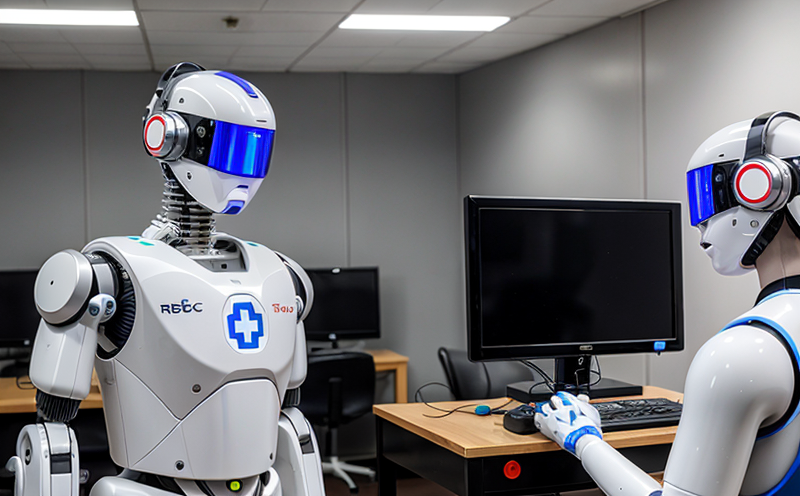ISO 80601-2-77 Performance Testing of Surgical Robots
The ISO 80601 series of international standards is designed to ensure medical devices are safe and effective for use. Specifically, ISO 80601-2-77 focuses on the performance testing of surgical robots used in minimally invasive procedures.
This standard provides a framework that ensures surgical robots meet stringent safety and performance criteria before being deployed in clinical settings. The scope of this testing includes evaluating the robot's precision, accuracy, repeatability, and consistency under various operational conditions. This is crucial because even minor deviations can have significant implications for patient outcomes.
The testing process involves a series of procedures that simulate real-world surgical scenarios. These tests are designed to verify that the robotic system performs within specified tolerances and meets all regulatory requirements. The instrumentation used in these tests includes high-precision measurement tools, computer simulations, and specialized software that can analyze the robot's performance across multiple dimensions.
One of the key aspects of ISO 80601-2-77 testing is the use of phantom tissues for calibration and validation. These phantoms are designed to mimic human tissue properties as closely as possible, allowing engineers to test the robot’s cutting, suturing, and other surgical functions under realistic conditions. The results from these tests provide critical data on the robot's performance, which can then be compared against predefined acceptance criteria.
Another important component of ISO 80601-2-77 testing is the evaluation of the robot’s control system. This includes assessing the stability and responsiveness of the robotic arm under various loads and conditions. The goal here is to ensure that the robot can operate smoothly and accurately, even in challenging surgical environments.
The standard also emphasizes the importance of ergonomics for the user interface of surgical robots. By testing how easy it is for surgeons to interact with the controls, ISO 80601-2-77 aims to reduce the risk of human error during complex procedures. This aspect ensures that the robotic system enhances rather than detracts from surgeon performance.
In addition to these technical aspects, ISO 80601-2-77 also addresses the environmental impact and sustainability of surgical robots. The testing process includes evaluating factors such as energy consumption and waste generation. By focusing on these areas, manufacturers can develop more sustainable robotic systems that have a lower carbon footprint while maintaining high levels of performance.
- Energy Efficiency: Testing for optimal power usage during various tasks
- Material Recyclability: Assessing the recyclability of robot components
- Waste Minimization: Evaluating methods to reduce waste in manufacturing and operation
The comprehensive nature of ISO 80601-2-77 testing ensures that surgical robots are not only safe but also highly efficient and environmentally friendly. This standard plays a vital role in advancing the field of medical robotics by setting industry benchmarks for performance, safety, and sustainability.
Why It Matters
The importance of ISO 80601-2-77 testing cannot be overstated, especially given the rapid advancements in surgical robots. These devices are increasingly being used to perform complex procedures with greater precision than traditional methods. However, without rigorous testing, there is always a risk that these innovations may introduce new risks or challenges for patients.
By adhering to ISO 80601-2-77 standards, manufacturers and hospitals can ensure that surgical robots meet the highest safety and performance benchmarks. This not only protects patient health but also enhances the reputation of healthcare providers who use these advanced technologies.
The testing process helps identify potential issues early in the development cycle, allowing for corrective actions to be taken before the product reaches the market. This proactive approach ensures that surgical robots are reliable and effective tools for surgeons, ultimately leading to better patient outcomes.
In addition, compliance with ISO 80601-2-77 is a requirement for regulatory approval in many countries around the world. Hospitals and clinics must ensure they are using devices that have undergone thorough testing to meet these standards. This underscores the critical role of this testing process in maintaining quality and safety in medical practices.
The benefits of ISO 80601-2-77 go beyond just compliance; they also contribute to innovation within the industry. By providing a clear set of guidelines, this standard encourages manufacturers to push the boundaries of what is possible with surgical robots. This fosters a competitive environment where companies strive to develop more advanced and efficient devices.
Benefits
The implementation of ISO 80601-2-77 performance testing offers numerous benefits that are essential for maintaining high standards in medical robotics:
- Enhanced Patient Safety: By ensuring precise and consistent robotic movements, this standard minimizes the risk of complications during surgical procedures.
- Improved Surgical Outcomes: The rigorous testing process helps identify potential issues early on, leading to more successful surgeries with better patient recovery times.
- Regulatory Compliance: Meeting ISO 80601-2-77 requirements is a prerequisite for gaining regulatory approval in many countries, ensuring that robotic systems meet global safety and performance standards.
- Innovation Promotion: The clear guidelines provided by this standard encourage manufacturers to innovate and develop more advanced surgical robots.
- Ethical Responsibility: By focusing on both patient safety and environmental sustainability, ISO 80601-2-77 ensures that medical robotics contributes positively to society.
In summary, ISO 80601-2-77 performance testing is essential for ensuring the reliability, effectiveness, and safety of surgical robots. It plays a crucial role in advancing the field of medical robotics while maintaining high standards of quality and care.





